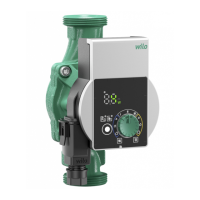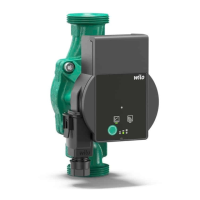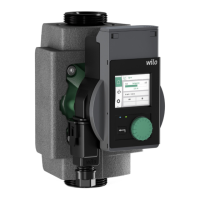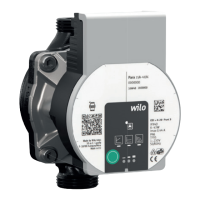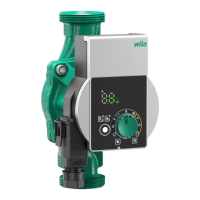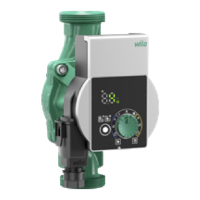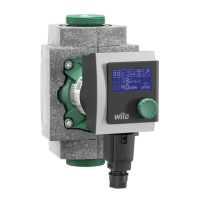Installation and operating instructions WILO Mather and Platt – Sump Pumps 25
9.5 Availability of liquid
Efficient operation of the pump depends upon the fine running
clearances of internal hydraulic components which are
lubricated by pumped fluid. Sufficient fluid must be available to
ensure that the pump is flooded at all times to prevent seizure
of the internal components. Wherever external
flushing/lubrication is provided it should be available before
starting the pump.
If on starting, a pump fails to generate its rated delivery head,
as indicated on the pump nameplate, it must be stopped
immediately; the cause must be ascertained and rectified,
before re-starting.
Ensure that minimum submergence is available as
recommended. Open all ancillary inlet and outlet isolating
valves such as air vents, leak-off connections etc.
CAUTION! Danger of Dry Run !
Any attempt to run the pump dry may result in seizure of the
rotating internal components.
9.6 Direction of rotation
It is absolutely essential that the rotation of the motor be
checked before installing the coupling drive element. Incorrect
rotation of the pump, for even a short time, can damage the
impeller, casing, shaft and shaft seal. Always check the
direction arrow which is cast on the motor stool.
9.7 Coupling Installation (Ref. fig. 13 & 14; Pg. No. 12)
Turn off the driver power and lock it out so that the driver
cannot be started during the coupling assembly. Non-spacer
couplings are used. Mount coupling hubs/sheaves on pump and
motor shafts prior to attaching motor to the motor stool.
The coupling should be installed as advised by the coupling
manufacturer. Remove all protective material from the
coupling and shaft before installing the coupling.
9.8 Starting the pump & running checks
To avoid pump damage or injury to operating personnel during
start-up and operation,
• DO NOT operates the pump outside of design parameters.
• DO NOT run with a closed discharge
• DO NOT operate with safety devices removed (such as coupling
guard)
• DO NOT run the pump dry.
• Minimum submergence level should be as per recommended.
• All flush lines must be started & regulated
• When all the foregoing pre-start checks are satisfactory, Start the
pump and check the direction of rotation (indicated by a direction
arrow on the motor stool) otherwise stop the pump immediately
for correction of direction of rotation.
• Open the delivery valve slowly and bring the pump gradually
up to its rated parameters indicated in the data sheet/name
plate and based on pressure gauge and ammeter readings.
Unless the pump is fitted with a special leak off device, it
should not be run for a long period against a closed delivery
valve.
• Check that the driving unit is not being overloaded during
valve opening. Overloading may occur if the pump is
discharging into an empty system. If the pumping unit fails
to generate at least its rated delivery pressure it must be
stopped immediately, the cause ascertained.
• Check that the bearing is not overheating. Bearings will
normally run at a temperature of 30˚C to 35˚C above
ambient temperature. The ideal running temperature of
bearings is 40˚C to 60˚C for ball bearings and 40˚C to 55˚C
for spherical roller bearings. The temperature should never
exceed 85˚C for bearings. If the bearings are overheating its
cause should be investigated immediately.
• Check vibration of pump set and ensure that vibration level
is within limits specified as per HIS standard (see page no. 26
for reference)
• The pumps may be run for 8 hours trial operation and all the
parameters like delivery pressure, current, bearing
temperature, etc. be recorded periodically.
• Make the following checks at regular intervals. It is
recommended that they be made at every change of shift.
• Check the suction and discharge pressure gauge for normal
operating pressure, if there is significant drop in the suction
or discharge pressure the pump may have lost its supply. In
the event of this fault occurring, the pump must be stopped
immediately, and the cause of liquid loss eliminated.
• Check the mechanical seal or stuffing box assembly for
overheating if applicable.
CAUTION!
If pumps fail to generate its rated delivery pressure
as indicated on the pump nameplate. It must be
stopped immediately, the cause ascertained, the
fault rectified and then restart. (Refer point no. 12
Page No. 30 for detail information)
9.9 Normal Shutdown
WARNING! Risk of Burns!
If the fluid temperature and system pressure is high,
close the isolation valves upstream (in case of
barrel pumps) and downstream of the pump.
Initially let the pump cool.
Stop the driver of the pump. When the pump has come to
rest, close the delivery valve. Isolate any ancillary supplies
.
9.10 Emergency Shutdown
In the event of any malfunction of the equipment, switch off
the pump set. When the pump has come to rest, close the
discharge valves, isolate the driving unit power supply &
rectify the fault.

